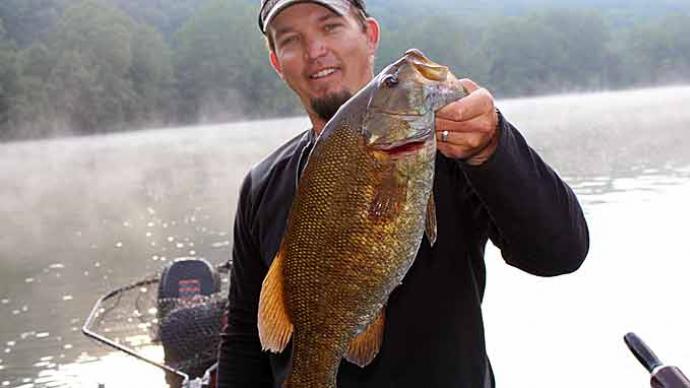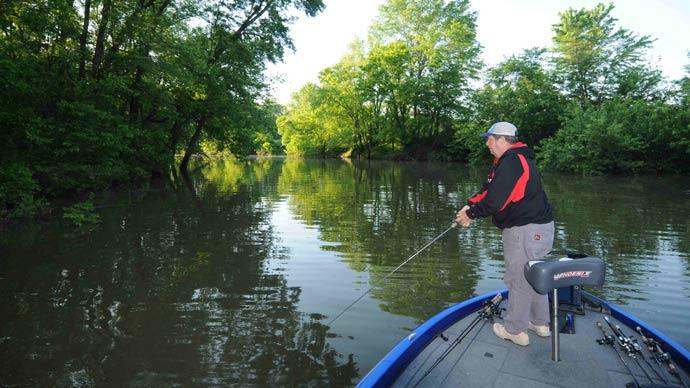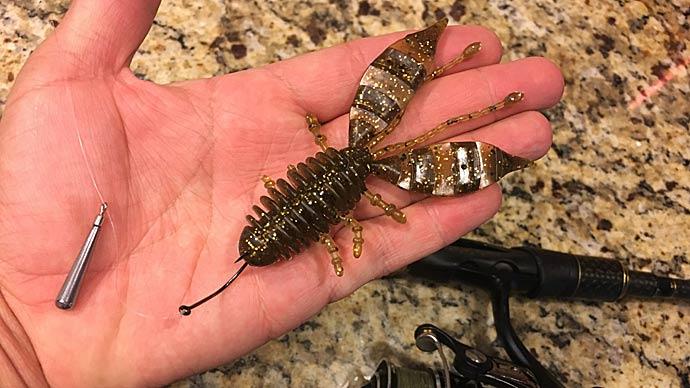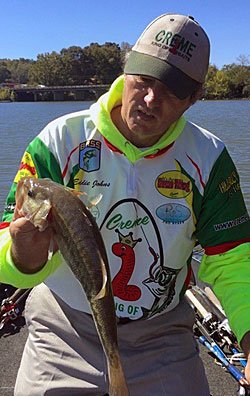
You may remember Eddie Johns from the article about keeping a fishing log. He’s the dude who wins an average of one out of every three tournaments he fishes. WINS. His stats are off the charts if you add just being in the money. Eddie has fished for over 30 years. He’s learned a thing or two. He watches the big tournament circuits and keeps current on the latest and greatest new lures and techniques. Doing so does not mean he neglects tried and true baits. One of his favorites is the Do-Nothing rig. Do-Nothing refers to the Carolina rig or the worm itself, and Ike-Con Lures sells the Do-Nothing Worm.
In 1985 Jack Chancellor won the Bassmaster Classic with a three-day total of 19 fish that weighed 45 pounds. He credited the Do-Nothing worm with his win, and sales skyrocketed. But that was then. Although the lure is enjoying some resurgence, Eddie says that for the most part, “these young squirts don’t think about it.” But Eddie has been fishing these worms for a long time when he first started buying them, they were 2 for 25 cents. In the late 70s, he immediately lost the first one he tied on. He was a bit more careful with that second worm and caught a 7- or 8-pound bass on it. After that, he was hooked.
One of the benefits of this lure, Eddie said, is that you can change the weight without changing the size of the bait. The Do-Nothing is simply a small, ribbed worm that comes pre-rigged with two hooks and no weight. A loop of 15-pound-test line comes out the front of the lure, and you simply clip your snap swivel to that loop. Most often, the Do-Nothing is fished on a Carolina rig. The line inside the worm makes it buoyant and barely sinks in the water. A 7- to 7-1/2 foot medium-light rod is an ideal Do-Nothing rig, and Eddie spools up with 14-pound-test line. In clear water, he attaches the worm with a 10-pound-test leader, and if the water is dirty, he’ll use 12-pound line. R & S Rods made his Do-Nothing rod – you call them and tell them what you want, and they build it for you – you choose the blank, handle, and all. You can even include your name, artwork, etc. It’s a sweet deal.
In winter, with water temps in the low 50’s, he uses a 4-foot leader, and once the temps climb above 55, he shortens it to 3 feet. One of these beauties is that even though you are fishing a finesse worm, you can still get a good cast with it, even if it’s windy. Cast it out, let it hit bottom, and then move about six to 12 inches. Give it time to sink before moving it again. Eddie suggests picturing a feather in your mind to get the timing right. Imagine dropping that feather from about 8 inches off the ground, and don’t move your lure until that feather hits the ground.
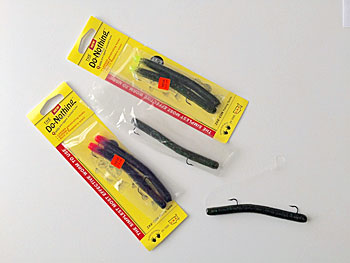
Sometimes you’ll feel a tug, but fishing the Do-Nothing is a line-watching game for the most part. If the line is moving, you’re on. It’s an excellent bait for kids because you don’t have to feel the bite or set the hook hard. The fish takes the whole thing because it’s such a small worm, and 97% of the time, both hooks are in the fish’s mouth. To set the hook, you just need to give it a little jerk and reel it in. Eddie says hit yourself in the chest with the rod handle to set the hook, then reel. The one drawback of this worm is that it gets snagged quite a bit because of the two open hooks. It’s such a fish-catching machine that Eddie doesn’t mind planning ahead.
He keeps at least two rods rigged up with the Do-Nothing, especially on tournament days. That way, if he breaks off on one, he can just pick up the other one. Also, he slices a pool noodle into one-foot lengths and uses it to keep his Do-Nothings ready to tie on. The night before going out, he’ll tie up a bunch of them with three-foot leaders and a bunch more with four-foot leaders. He ties a loop in the end and simply wraps them around the pool noodle. You can push the hooks into the noodle, and they stay organized and ready to use, and you don’t even have to tie them on – you just attach them to the swivel with the loop you tied in the end.
Slip the weight onto your main line, and then tie on a swivel. Eddie never uses a barrel swivel; he prefers the plain old snap swivels because they make it so easy to attach his pre-rigged leaders.
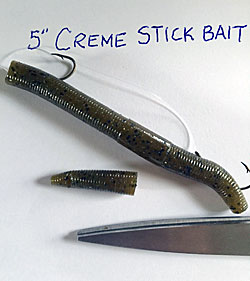
You can swim a Do-Nothing worm in open water or down rocky banks, but if you bend the hook points just a little toward the body, you can get it through a surprising amount of brush without hanging up. Or you can cut a tiny piece of corkboard and stick it on the end of the hook to make it weedless. It will easily go through the cork when you need it to, but the cork will deflect light weeds. You can also use a little piece of sponge on the tip of the hook to make it weedless. Squeeze a tiny bit of sponge and dip it in scent before letting go. It will soak up the scent, and once you put that on the tip of the hook, it helps the lure get through weeds and creates a scent bubble around the lure. Eddie swears by Brush Pile Fish Attractant.
The Do-Nothing is a killer bait in current because it gets carried along right into the eddies where the bass hang out. It’s fantastic for smallmouth. Eddie has gone as light as a ¼-ounce weight and as heavy as an ounce – it all depends on how fast he needs to get it down. Use a slightly heavier weight in current and very light weight on windless days when you’re pitching it around piers and structure. You can also flip a Do-Nothing rig. Use a 2-1/2 foot leader and let it float down once you’ve flipped to the cover.
If you want to go ultra-finesse, you can even fish a Do-Nothing rig on spinning gear with no weight at all. You’ll still use the swivel, so there is a tiny bit of weight, but not much. It’s an incredibly slow way to fish, but sometimes that’s what it takes. Eddie once caught an 11-pound bass on a weightless Do-Nothing rig. In winter or summer, he likes to fish it this way on steeper areas like cliffs and bluffs. Get right on the bank, throw it ahead, and then let it fall as you come toward it. Weightless, it’s also a dynamite bed bait. This is such a slow way to fish that he doesn’t do it often, but it still made the Top 5 on his list of ways to win tournaments.
Eddie has watched this bait work, and in the water, it acts differently from other baits because it is so light – it lets the water move it. Fish don’t run up and attack it. They just watch until it gets where they want it, then suck it in and just hold on to it. Watch your line. Keep a finger on it as well. They don’t try to kill it. They just pick it up and lay it back down. It practically works itself, so let it do its thing. You – do nothing.
___________________________
More tips:
Eddie ALWAYS sharpens the hook on any bait before he uses it, regardless of what kind of hook it is. He uses a small triangle file, slips it under the barb, and files it so it sticks out a tiny bit more – it holds a lot better that way. Hooks come out sharp, but they don’t stay that way for long, so after a few fish, he re-sharpens the hook. This is particularly important on the Do-Nothing.
Eddie also makes his pre-rigged worms for the Do-Nothing rig. Starting with a Creme worm, he cuts the ends off, so it isn’t pointed. He ties a hook on a piece of line, leaving a 6-inch tag, then ties another hook on the tag line. He feeds the hooks through the worm just like you would if you were going to Texas Rig, but he leaves the eye inside the worm and the hook exposed. He’s been doing this for decades and says having that bit of line on the outside of the worm doesn’t make any difference. After tying a loop in front of the lure, he’s all set. It’s a bit of work, but it saves some money.


